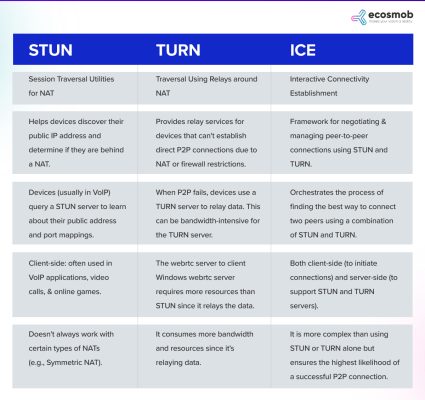The field of web-based real-time communication (RTC) has experienced rapid expansion. When jumping into WebRTC programming, it’s inevitable not to encounter three buzzwords that are the true essence of the technology: STUN, TURN, and ICE.
These components inspire any trustworthy WebRTC server, guaranteeing smooth peer-to-peer communication. Understanding what STUN, TURN, and ICE protocols?, and the technical aspects of WebRTC is essential while configuring the WebRTC server. This blog post describes these three technologies in detail, highlights their importance, and provides best practices to harness their full potential in creating WebRTC solutions.
What is WebRTC?
WebRTC, or Web Real-Time Communication, is an open-source project that offers real-time communication features to mobile and web applications using API. Video conferences, file transfers, chat, and desktop sharing are among its most popular uses, all of which don’t require the installation of extra plugins or applications.
However, WebRTC’s P2P feature poses unique challenges. Most devices use network address translators (NAT) and firewalls for security. Direct connectivity between these devices may, therefore, become difficult.
Understanding of WebRTC API
The WebRTC API provides the foundational elements web browsers need to communicate in real time. Understanding the API is crucial for developers looking to implement WebRTC. It contains commands for handling network signals, connecting, and managing media capture.
To handle the complexities of peer-to-peer communications, such as processing ICE candidates, managing STUN and TURN server configurations, and guaranteeing flawless connection formation, Outsourcing Partners for WebRTC Development and developers must thoroughly understand the WebRTC API.
Firewalls and NAT Conundrum in WebRTC
The most significant obstacle to WebRTC development is the presence of firewalls and network address translators (NAT). A private network’s majority of devices are assigned a local IP address. By converting these local IP addresses to public ones, NAT enables the devices to communicate with the public Internet. On the other hand, this can cause WebRTC issues for connections coming in from the outside. Conversely, unsolicited inbound traffic is intended to be blocked by firewalls, which can interfere with the STUN/TURN server for WebRTC communication.
It is where STUN, TURN, TURNS protocol, and ICE are helpful.
Don’t Miss This Related Post: Enhancing WebRTC Capabilities Through SDN
What are STUN, TURN, and ICE: Best WebRTC Server?
Let’s discuss how STUN vs. TURN vs. ICE varies from each other:
1. STUN (Session Traversal Utilities for NAT): Discovering Public IP Address
A STUN server can assist WebRTC peers in acquiring their public IP address. When a device sends a request, a STUN server answers with the public IP address and port. Since NAT hides multiple private IP addresses behind a single public IP address, with greater security, it is crucial.
STUN to the Rescue
- Peers can utilize the STUN server to find each other’s public addresses.
- To establish a WebRTC connection, a device behind a NAT contacts a STUN server.
- The device can connect to additional peers by sharing its public IP address and port, provided by the server in response.
Limitation: The mapping of internal to public IP addresses is dynamic because STUN is not helpful if both peers are behind symmetric NATs. TURN servers become necessary in these situations.
Best Practices for STUN Server
- Deploying Several STUN Servers: In WebRTC development, setting up numerous STUN servers is recommended as one of the best WebRTC servers. The likelihood of obtaining the public IP address increases if one server fails.
- Update STUN servers frequently: To keep your WebRTC solution development cycle strong, make sure your STUN servers are always up to date and operating at peak performance.
2. TURN (Traversal Using Relays around NAT): A Reliable Relay
TURN servers are used in instances when STUN fails. It can occur when both peers are behind firewalls or restrictive NATs. Since TURN servers function as a relay between the two peers, any communication will go via them.
Let’s dig into a streamlined, step-by-step procedure of WebRTC with ICE Server Solutions:
- NAT/firewall constraints prevent Peer A from connecting directly to Peer B.
- Peer A sends data to the TURN server.
- After that, Peer B receives this data from the TURN server.
- Similarly, Peer B sends data to the TURN server, which passes it on to Peer A.
This procedure guarantees WebRTC communication to occur even under constrained network settings. Nevertheless, TURN servers are regarded as a fallback strategy because they consume more bandwidth than a straight P2P connection.
Best Practices for TURN
- Provide Sufficient Resources: The accurate media data—such as audio and video content protection—is managed by TURN servers. As a result, they need a large amount of computing power and bandwidth, mainly when supporting numerous sessions.
- TURN Server Security: Relay malicious traffic using WebRTC TURN servers. Make sure they configure securely, utilizing additional authentication techniques and credentials.
- Track Usage: Check the resource usage of your TURN server regularly. A high reliance on TURN could mean that STUN is not functioning as well as it should, resulting in higher expenses and worse performance.
3. ICE (Interactive Connectivity Establishment): Making the Best Connection Choices
ICE can manage peer negotiation regarding the most effective way to connect. It provides mechanisms for peers to connect directly or, if needed, through a relay using STUN and TURN. WebRTC with ICE Server Solutions alludes to this complex procedure of determining the optimal connection technique.
Let’s specify this with an example:
When two peers want to talk to each other, they sometimes need to learn how the data should go. ICE functions by compiling several candidates (potential routes) for the relationship. These applicants may be:
- Host candidates: Direct IP addresses of the devices.
- Candidates for Reflexive Servers: Public IP addresses acquired with STUN.
- Relay Candidates: The TURN servers’ addresses.
The peers trade these candidates and test connections to identify the most effective route. The host or server reflexive direct path is used if it is available. If not, information is transmitted via the TURN server.
Best Practices for ICE
- Peer Connection: In Peer Connection, it’s easy to connect two applications and use them on two different PCs.
- Make Local Connections a Priority: ICE should prioritize this direct connection for best results if both peers connect to the same local network.
- ICE Timeout Tuning: Finding the right balance between allowing ICE enough time to establish a connection and ensuring users don’t have to wait too long when developing WebRTC solutions. Adapt the timeouts in light of practical testing.
- Concerning Geographical Places: Set up ICE to give preference to servers closer to the user’s location if you’re utilizing several TURN servers. It can cut latency considerably.
Let’s Explore STUN, TURN, and ICE servers now!
STUN vs TURN vs ICE
It’s essential to know the difference. Although both support WebRTC‘s NAT traversal procedure, STUN and TURN have different functions. A simple WebRTC server will often employ STUN, particularly if peer-to-peer connectivity isn’t prohibited. However, TURN servers become essential for more widespread applications where guaranteed connectivity is required. However, unlike STUN or TURN, which are isolated servers, ICE is a protocol that determines the optimal connection path by utilizing data from both.

Following the recommended principles mentioned above can guarantee a smooth communication experience for your users, regardless of your goals for the best WebRTC server configuration, from a Webrtc server to a client Windows Webrtc server.
Ecosmob- The Triad for Smooth Communication
In the realm of real-time online communication, WebRTC development has revolutionized communication. The real magic is found in the internal solid processes that maintain connectedness in various network conditions. When direct contact isn’t possible, the best webRTC server, TURN, acts as a relay; STUN assists peers in understanding their public persona; and ICE combines the two to ensure the optimal connecting pathway is selected.
Businesses must comprehend these elements to contemplate developing WebRTC solutions in the education sector, hospitality, and many more. The quality and dependability of your real-time communication solutions can be significantly impacted by ensuring you have the appropriate processes. We at Ecosmob provide great satisfaction in our in-depth knowledge of WebRTC and its underlying mechanics. Please contact us for help with STUN, TURN, TURNS protocol, and ICE setups or to incorporate WebRTC into your solutions. Together, let’s make the most of WebRTC’s potential.
FAQs
How would I make use of a STUN server?
The primary purpose of a STUN server is to discover a device’s port and public IP address. When two devices need to connect directly but are separated by NATs, it can be helpful in certain situations.
Why is WebRTC TURN required?
TURN is crucial when peer-to-peer connections cannot be made, usually because of firewalls or restricted NATs. By serving as a go-between, TURN transmits data between the two peers.
What function does ICE provide in WebRTC?
It is the responsibility of ICE to make sure that the communication takes the most reliable and efficient route. It accomplishes this by attempting a direct connection using STUN first and TURN if required.
Can I use Windows to operate a WebRTC server?
Indeed, specific WebRTC applications intend to operate on Windows. Depending on your needs, you may want to build an environment where “WebRTC server to client windows” is used.
In what ways does ICE Server Solutions’ WebRTC improve connectivity?
Peer-to-peer connection success rates increase when WebRTC is used with ICE Server Solutions. It guarantees the best paths for communication when going past firewalls and NATs by utilizing the STUN and TURN techniques.















